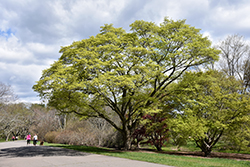Height: 30 feet
Spread: 25 feet
Sunlight:
![]()
Hardiness Zone: 4
Description:
A pretty smaller landscape tree with a good rounded and vase-shaped form, interesting smooth gray bark and good fall color; attractive in a subdued sort of way, becoming more and more popular and justifiably so
Ornamental Features
Painted Maple is blanketed in stunning corymbs of yellow flowers hanging below the branches in early spring before the leaves. It has dark green deciduous foliage which emerges deep purple in spring. The lobed leaves turn outstanding shades of yellow and orange in the fall. The smooth gray bark adds an interesting dimension to the landscape.
Landscape Attributes
Painted Maple is a dense deciduous tree with an upright spreading habit of growth. Its average texture blends into the landscape, but can be balanced by one or two finer or coarser trees or shrubs for an effective composition.
This is a relatively low maintenance tree, and should only be pruned in summer after the leaves have fully developed, as it may 'bleed' sap if pruned in late winter or early spring. It has no significant negative characteristics.
Painted Maple is recommended for the following landscape applications;
- Accent
Planting & Growing
Painted Maple will grow to be about 30 feet tall at maturity, with a spread of 25 feet. It has a low canopy with a typical clearance of 5 feet from the ground, and should not be planted underneath power lines. It grows at a slow rate, and under ideal conditions can be expected to live for 80 years or more.
This tree should only be grown in full sunlight. It is very adaptable to both dry and moist locations, and should do just fine under average home landscape conditions. It is considered to be drought-tolerant, and thus makes an ideal choice for xeriscaping or the moisture-conserving landscape. It is not particular as to soil pH, but grows best in clay soils. It is highly tolerant of urban pollution and will even thrive in inner city environments. This is a selected variety of a species not originally from North America.
